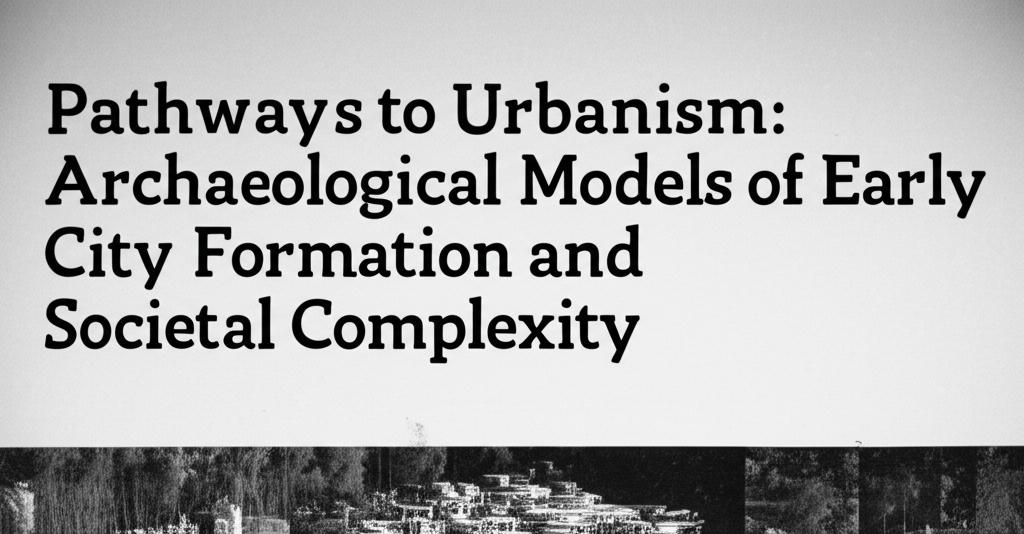The study of early urbanism and societal complexity through archaeological models is a dynamic and evolving field. Recent research highlights a shift towards more diverse and people-centric approaches to understanding how the first cities emerged and developed.
Core Tenets of Early Urbanism:At its heart, urbanism involves two fundamental processes: the concentration of people in a specific area and the centralization of institutions and activities within that space. This focus places individuals, their activities, and their social networks—including interactions with both human and non-human elements—at the forefront of analysis. This perspective offers fresh insights into urban life and the functions of cities in early societies.
Diverse Pathways to Urbanization:Scholars increasingly recognize that premodern urbanization was not a monolithic process. Instead, various forms of urbanism emerged in different parts of the world, influenced by unique local conditions and historical trajectories. This contrasts with older, more linear "neo-evolutionary" models that suggested societies progressed through fixed stages of complexity. Current research emphasizes the varied pathways to urbanized societies, even within a single region. For example, studies in northern Mesopotamia indicate that early urbanism was a phased and pulsating phenomenon, with older, slowly growing "hubs" existing alongside rapidly expanding new sites. This highlights the intricate and non-uniform nature of urban growth.
The Interplay of Top-Down and Bottom-Up Processes:A significant area of inquiry involves the interplay between top-down (institutional) and bottom-up (generative) forces in shaping urban life. While elites and centralized authorities undoubtedly played roles, new perspectives also emphasize "power from below" mechanisms and modes of collective governance. For instance, some models propose that early Mesopotamian urbanism originated from an extension of household structures rather than solely as a functional adaptation for elite goals. Neighborhoods, often seen as a universal feature of cities, provide a key example of generative forces, where residents' actions and interactions, independent of rulers, shape the urban fabric.
The Role of Agriculture:The relationship between urbanism and agriculture continues to be debated. While some theories, like Jane Jacobs' "cities first" model, posited that cities predated agriculture, current archaeological evidence from regions like the Near East, China, and Mesoamerica overwhelmingly supports the temporal precedence of agriculture before widespread urbanism. However, the interplay was complex. For example, in some areas, the expansion of sedentary villages and early irrigation practices coincided, while in others, urban expansion occurred alongside the adoption of new agricultural techniques like manuring. It's likely that a complex set of non-linear processes, rather than a simple cause-and-effect relationship, drove these developments.
Methodological and Theoretical Advances:The field has benefited greatly from methodological advancements, ranging from LiDAR (Light Detection and Ranging) for mapping ancient landscapes to bioarchaeology for understanding the health and diet of past urban populations. Furthermore, concepts and methods from other disciplines, including economics, geography, sociology, and complexity science, are increasingly applied to archaeological data. Settlement scaling theory, for instance, which examines relationships between settlement size, population, and socioeconomic outputs, is proving valuable for analyzing both ancient and modern urban systems. The archaeological record, with its long-term perspective, is crucial for testing and refining such theories of urbanization.
Understanding Urban Dynamics:Research is exploring not only the rise of cities but also their decline and abandonment, focusing on factors contributing to urban persistence and resilience. The study of urban heritage, including the tangible remains of buildings and artifacts and the intangible significance of ancient urban spaces, also contributes to our understanding. The theory of fragmentation, for example, examines how urban archaeological heritage is formed through both intentional acts and unintentional events, and how these fragments contribute to the ongoing narrative of a city.
Key Themes in Current Research:- Defining Cities: Ongoing discussions about what constitutes a "city" in different historical and cultural contexts.
- Functions of Cities: Examining the roles of cities as centers of population, institutions, activities, and innovation.
- Urban Networks: Understanding the relationships between cities and their hinterlands, as well as inter-city connections.
- Social Heterogeneity and Inequality: Investigating the diverse social makeup of early cities and the emergence of social stratification.
- Urban Lifeways: Reconstructing the daily lives, social interactions, and experiences of people in early urban environments.
In essence, current archaeological models of early city formation are moving beyond simplistic, universal explanations. They embrace the diversity of urban experiences across time and space, integrating sophisticated theoretical frameworks and cutting-edge methodologies to paint a more nuanced and people-focused picture of how human societies first created and inhabited cities. This ongoing research not only illuminates the past but also offers valuable perspectives for understanding contemporary urban challenges.

